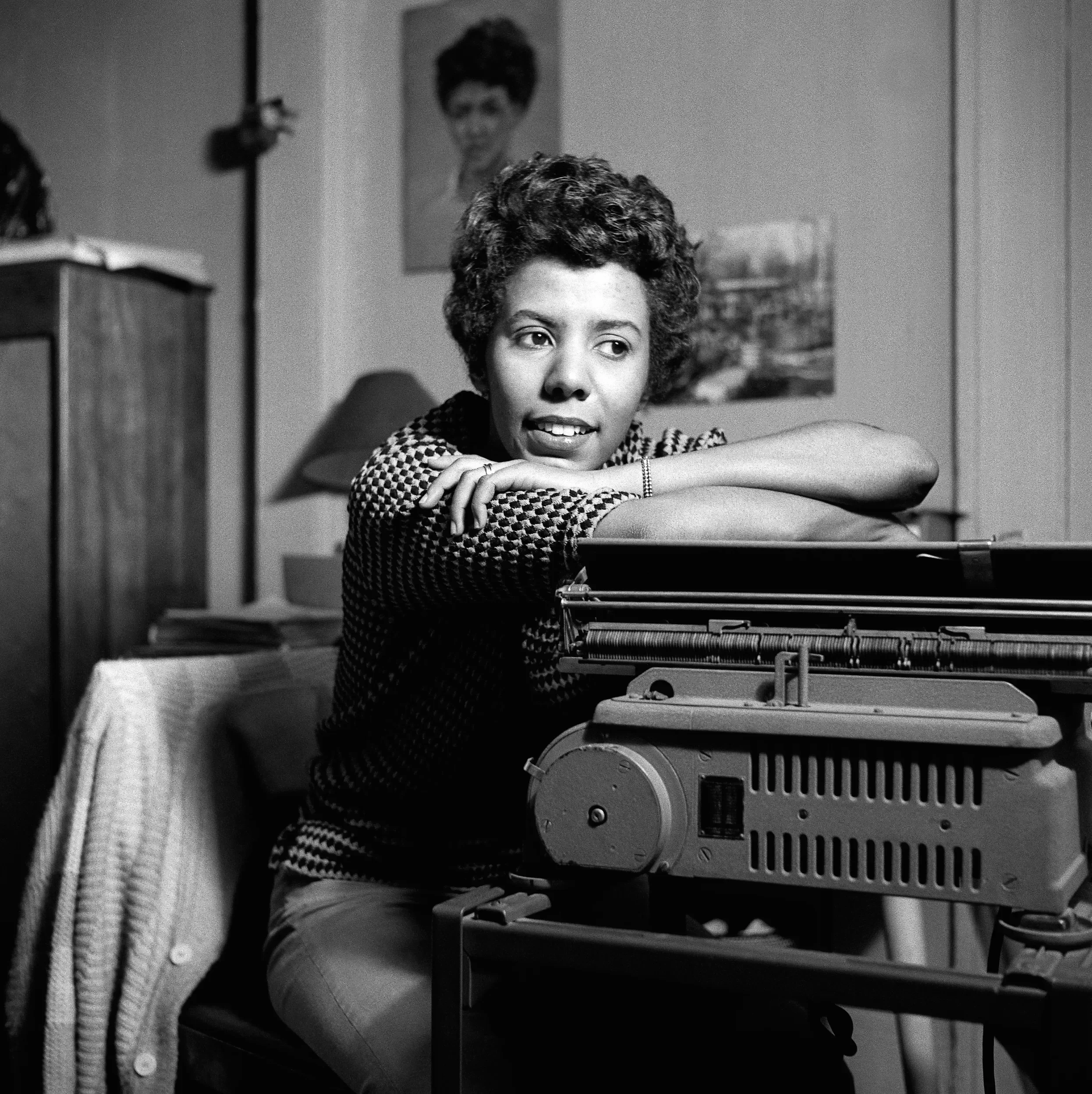LORRAINE HANSBERRY
Biography
Hansberry was born in Chicago, Illinois in 1930. She was the daughter of a real estate entrepreneur, Carl Hansberry, and schoolteacher, Nannie Hansberry, as well as the niece of Pan-Africanist scholar and college professor Leo Hansberry. Her own family’s landmark court case against discriminatory real estate covenants in Chicago would serve as inspiration for her seminal Broadway play, A Raisin in the Sun. Raisin, her best-known work, would eventually become a highly lauded film starring Sidney Poitier, Ruby Dee, Claudia McNeil, and Diana Sands.
Hansberry originally wanted to be an artist when she attended the University of Wisconsin, but soon changed her focus to study drama and stage design. After two years, she left college for New York to serve as a writer and editor of Paul Robeson’s left-wing newspaper Freedom. Hansberry, an outspoken Communist, was committed to racial equity and participated in civil rights demonstrations. It was at one of these demonstrations that Hansberry met her husband and closest friend, Robert Nemiroff.
Despite her being married, Hansberry secretly affirmed her homosexuality in various correspondence and in short stories later discovered in archives. She continued to write plays, short stories, and articles in addition to delivering speeches regarding race relations in the United States. She became close friends with James Baldwin and Nina Simone. It was with those friends and Nemiroff that she kept a secret about the pancreatic cancer that would eventually take her life on January 12, 1965, at age 34. Simone penned the song “Young, Gifted and Black” in tribute to her good friend. (Full Bio)
Plays
A RAISIN IN THE SUN (1959)
Set on Chicago’s South Side, the plot revolves around the divergent dreams and conflicts within three generations of the Younger family: son Walter Lee, his wife Ruth, his sister Beneatha, his son Travis, and matriarch Lena. When her deceased husband’s insurance money comes through, Mama Lena dreams of moving to a new home and a better neighborhood in Chicago. Walter Lee, a chauffeur, has other plans: buying a liquor store and being his own man. Beneatha dreams of medical school. The tensions and prejudice they face form this seminal American drama. The Younger family’s heroic struggle to retain dignity in a harsh and changing world is a searing and timeless document of hope and inspiration. (Source)
Cast Requirement: 12 (4f, 8m)
Characters: Ruth Younger, Travis Younger, Walter Lee Younger, Beneatha Younger, Lena Younger, Joseph Asagai, George Murchison, Karl Lindner, Bobo, Moving Men, Mrs. Johnson
Publication: A Raisin in the Sun. Vintage Books, 1994 (Link)
A Raisin in the Sun. Samuel French, 1959. (Link)
+ MORE INFO
A Raisin in the Sun opened on Broadway at the Ethel Barrymore Theatre in 1959. The director for this production was Lloyd Richards; set and costume designs were by Ralph Alswang; costume design was by Virginia Volland. The cast for this production included:
- Ruth Younger - Ruby Dee
- Travis Younger - Glynn Turman
- Walter Lee Younger - Sidney Poitier
- Beneatha Younger - Diana Sands
- Lena Younger - Claudia McNeil
- Joseph Asagai - Ivan Dixon
- Geoge Murchison - Louis Gossett
- Karl Lindner - John Fiedler
- Bobo - Lonne Elder III
- Moving Men - Ed Hall, Douglas Turner Ward
THE DRINKING GOURD (1959)
The Drinking Gourd of the title is the Big Dipper. For a slave in the South it pointed the way North, the way to freedom. Hannibal, the main character, is a slave about 19 years old who is thinking about running away. Hannibal says the only good slave is a bad slave. To keep his human dignity he breaks tools, works slowly, plays sick and often disappears for hours at a time. Because his mother is the master’s most trusted slave – she cooks for him – the master never comes down hard on Hannibal. But then, he gets old and sick and his 30-year-old son Everett takes over and works the slaves harder and longer because the soil is giving out. He hires an overseer who makes an example of Hannibal with devastating consequences. (Source)
Cast Requirement: 19+
Characters: The Soldier, Rissa, Sarah, Joshua, Hannibal, Hiram Sweet, Maria Sweet, Two Male House Servants, Everett Sweet, Tommy, Dr. Macon Bullett, Zeb Dudley, Elizabeth Dudley, Two Dudley Children, The Preacher, Coffin, A Driver, Slaves
Publication: The Collected Last Plays: Les Blancs; The Drinking Gourd; What Use Are Flowers?. Vintage Books, 1994. (Link)
+ MORE INFO
The Drinking Gourd was originally commissioned for television by NBC in 1959.
WHAT USE ARE FLOWERS? (1961)
At fifty-eight years of age Professor Charles Lewis Lawson, the principal character in What Use Are Flowers? gave up his position as a teacher of English and retired to a forest, where he became a hermit and remained twenty years. When, at the beginning of the action in the drama, he returns to "a plain somewhere in the world," he finds that civilization has been destroyed, presumably by war, and that peaceful desolation prevails there. The only survivors he finds are a group of savage children none of whom are more than ten years old. Lawson, now called the Hermit, endeavors to civilize the children by teaching them to understand, among other things, nature, beauty, and human relationships and responsibilities. (Source)
Cast Requirement: 3+
Characters: An Elderly and Scholarly Hermit, A Party of Children About Nine or Ten Years Old
Publication: The Collected Last Plays: Les Blancs; The Drinking Gourd; What Use Are Flowers?. Vintage Books, 1994. (Link)
THE SIGN IN SIDNEY BRUSTEIN’S WINDOW (1964)
This is the probing, hilarious and provocative story of Sidney, a disenchanted Greenwich Village intellectual, his wife Iris, an aspiring actress, and their colorful circle of friends and relations. Set against the shenanigans of a stormy political campaign, the play follows its characters in their unorthodox quests for meaningful lives in an age of corruption, alienation and cynicism. With compassion, humor and poignancy, the author examines questions concerning the fragility of love, morality and ethics, interracial relationships, drugs, rebellion, conformity and especially withdrawal from or commitment to the world. (Source)
Cast Requirement: 9 (3f, 6m)
Characters: David Ragin, Alton Scales, Sidney Brustein, Policeman, Mavis Parodus Bryson, Iris Parodus Brustein, Gloria Parodus, Wally O’Hara, Max
Publication: A Raisin in the Sun: and, The Sign in Sidney Brustein's Window. Vintage, 2004. (Link)
+ MORE INFO
The Sign in Sidney Brustein’s Window opened on Broadway at the Longacre Theatre in 1964. The production was directed by Peter Kass; the set design was by Jack Blackman; the costume design was by Fred Voelpol; the lighting design was by Jules Fisher; the production stage manager was Stephen Gardner. The cast for this production included:
- David Ragin - John Alderman
- Alton Scales - Ben Aliza
- Sidney Brustein - Gabriel Dell
- Policeman - Josip Elic
- Mavis Parodus Bryson - Alice Ghostley
- Iris Parodus Brustein - Rita Moreno
- Gloria Parodus - Cynthia O’Neal
- Wally O’Hara - Frank Schofield
- Max - Dolph Sweet
TO BE YOUNG, GIFTED, AND BLACK (1969)
A long-running success of the 1968/69 Off-Broadway season. Fast paced, powerful, touching and hilarious, this kaleidoscope of constantly shifting scenes, mood and images recreates the world of a great American woman and artist, Lorraine Hansberry. Uniquely and boldly, the play dramatically weaves through her life experiences and the times that shaped her. The actors slip ingeniously into and out of a variety of challenging roles spanning her life and experiences to the ultimate confrontation when cancer strikes her. Includes brilliantly highlighted scenes from her plays as well as letters, diaries, poems and personal reminiscences. A major statement of the American Black experience. (Source)
Cast Requirement: 8 (5f, 3m)
Characters: N/A
Publication: To Be Young, Gifted, and Black: A Portrait of Lorraine Hansberry in Her Own Words. Samuel French, 1999. (Link)
+ more info
To Be Young, Gifted, and Black premiered at the Cherry Lane Theatre in New York City in 1969. The play was adapted posthumously by Robert Nemiroff using the writing of Lorraine Hansberry. This production was directed by Gene Frankel; set design was by Merrill Sindler; lighting design was by Barry Arnold; sound design was by Gigi Cascio; visual effects were by Stuart Bigger. The cast for this production included:
Barbara Baxley, John Beal, Rita Gardner, Gertrude Jeannette, Janet League, Stephen Strimpell, Cicely Tyson, Andre Womble
LES BLANCS (1970)
Les Blancs prophetically confronts the hope and tragedy of Africa in revolution. The setting is a white Christian mission in a colony about to explode. The time is that hour of reckoning when no one, the guilty nor the innocent, can evade the consequences of white colonialism and imperatives of black liberation. Tshembe Matoseh, the English educated son of a chief, has come home to bury his father. He finds his teenage brother a near alcoholic and his older brother a priest and traitor to his people. Forswearing politics and wanting only to return to his wife and child in England, Tshembe is drawn into the conflict symbolized by a woman dancer, the powerful Spirit of Africa who pursues him. (Source)
Cast Requirement: 17+ (3f, 14m)
Characters: Dr. Marta Gotterling, Dr. Willy Dekoven, African Child, Madame Neilson, Witch Doctor, Second Soldier, Second African, Peter, Abioseh Matoseh, Tshembe Matoseh, Charlie Morris, First Soldier, Warrior, Major George Rice, Eric, First African, Third African, Drummers
Publication: The Collected Last Plays: Les Blancs; The Drinking Gourd; What Use Are Flowers?. Vintage Books, 1994. (Link)
+ more info
Les Blancs opened on Broadway at the Longacre Theatre in 1970. The production was directed by John Berry; the set design was by Peter Larkin; the costume design was by Jane Greenwood; the lighting design was by Neil Peter Jampolis; the sound design was by Jack Shearing; the production stage manager was Martin Gold. The cast for this production included:
- Dr. Marta Gotterling - Marie Andrews
- Dr. Willy Dekoven - Humbert Allen Astredo
- African Child - Gregory Beyer
- Drummer - Ladji Camara
- Madame Neilson - Lili Darvas
- Witch Doctor - Joan Derby
- Second Soldier - Gwyllum Evans
- Second African - George Fairley
- Peter - Clebert Ford
- Abioseh Matoseh - Earle Hyman
- Tshembe Matoseh - James Earl Jones
- Charlie Morris - Cameron Mitchell
- First Soldier - Garry Mitchell
- Warrior - Charles Moore
- Drummer - Charles Payne
- Major George Rice - Ralph Purdom
- Eric - Harold Scott
- First African - Dennis Tate
- Third African - William Ware
RESOURCES
other writings by hansberry
Essays:
"Simone de Beauvoir and The Second Sex: An American Commentary” (1957)
"In Defense of the Equality of Men” (1985)
Other:
Conversations With Lorraine Hansberry, Edited by Mollie Godfrey (Link)
Radical Vision: A Biography of Lorraine Hansberry by Soyica Diggs Colbert (Link)
“The Black Experience in Drama,” Films for the Humanities (Link)

